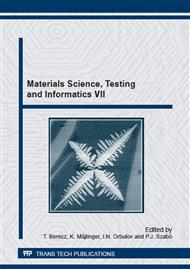[1]
David R., The Fundamental Principles of Composite Material Stiffness Predictions, University of the West of England, Bristol, (2006).
Google Scholar
[2]
Evgeny V. Morozov, Mechanics and Analysis of Fabric Composites and Structures, AUTEX Research Joumal, Vol. 4 No. 2, South Africa, (2004).
Google Scholar
[3]
W. D. Callister, Fundamentals of Materials Science and Engineering, fifth ed., John Wiley and Sons, New York, (2001).
Google Scholar
[4]
J. W. Martin, Materials for Engineering, third ed., Woodhead, Cambridge, (2006).
Google Scholar
[5]
M. F. Ashby, D. R. H. Jones, Engineering Materials 1, second ed., Butterworth-Heinemann, Oxford, (1996).
Google Scholar
[6]
C.S. Verma, V.M. Chariar, Development of layered laminate bamboo composite and their mechanical properties, Composites Part B 43 (2012) 1063-1069.
DOI: 10.1016/j.compositesb.2011.11.065
Google Scholar
[7]
C. Dong, I. J. Davies, Flexural and tensile moduli of unidirectional hybrid epoxy composites reinforced by S-2 glass and T700S carbon fibres, Materials and Design 54 (2014) 893-899.
DOI: 10.1016/j.matdes.2013.08.086
Google Scholar
[8]
C. Dong, I. J. Davies, Flexural and tensile strengths of unidirectional hybrid epoxy composites reinforced by S-2 glass and T700S carbon fibres, Materials and Design 54 (2014) 955-966.
DOI: 10.1016/j.matdes.2013.08.087
Google Scholar
[9]
H. He, J. Wangb, K. Li, J. Wanga, J. Gu Mixed resin and carbon fibres surface treatment for preparation of carbon fibres composites with good interfacial bonding strength, Materials and Design 31 (2010) 4631-4637.
DOI: 10.1016/j.matdes.2010.05.031
Google Scholar
[10]
R. Rikards, A. Chate, Identification of Elastic Properties of Composites by Method of Planning of Experiments, Composite Structures 42 (1998) 257-263.
DOI: 10.1016/s0263-8223(98)00071-3
Google Scholar
[11]
R. Rikards, A. Chate, G. Gailis, Identification of Elastic Properties of Laminates Based on Experiment Design, International Journal of Solids and Structures 38 (2001) 5097-5115.
DOI: 10.1016/s0020-7683(00)00349-8
Google Scholar
[12]
R. Rikards, A. Chate, W. Steinchen, A. Kessler, A.K. Bledzki, Method for identification of elastic properties of laminates based on experiment design, Composites Part B 30 (1999) 279–289.
DOI: 10.1016/s1359-8368(98)00059-6
Google Scholar


